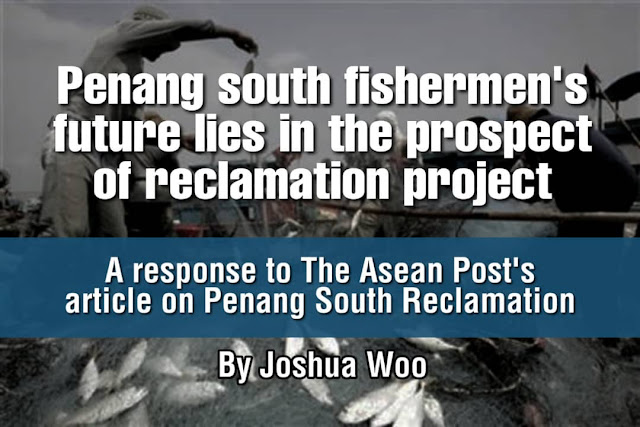A recent article about Penang’s marine life in The
Asean Post has given wrong impression about a reclamation proposal and the
fisheries condition in the State. (‘Penang’s new islands will kill marine life,’ 23 June 2019)
I would like to provide facts to correct the article’s misleading
portrayal of the matter.
Exaggeration of fishermen’s plight
The article states that “The proposed area for the
artificial islands is currently the place where most fishermen around
the state coastline live and work. Objections have come from this group
of fishermen whose livelihoods and villages are threatened most by this
project.” (Emphasis added)
This is wrong as the number of fishermen living in Barat
Daya district, where the reclamation site is located, is 912 out of 2,905
registered fishermen in Penang. That means most of the fishermen are living
at other coastline in the State, not at the reclamation site.
Besides exaggerating the number of fishermen staying near
the reclamation site, the article also exaggerates their objections. More
than 50 percent of the fishermen staying there actually support the reclamation
project.
The approving
voices of the fishermen who support the project is surprisingly neglected
in the article.
Ignoring actual threat to marine life
The article’s single-minded criticism of the future
threat to the marine life is absolutely blinded to the fact that marine life in
the area is already depleting due to overfishing, even before a single grain of
sand is dropped into the sea for reclamation.
Fisheries Department director-general Datuk Munir Mohd
Nawi had acknowledged
this matter late last year, that the depletion of fishes was due to overfishing.
Of the 7,800 marine species around the world, 90 percent were fully fished or
overfished.
In Penang, the destruction of sea bed at the reclamation
site has been happening due to overfishing through destructive
fishing method such as the usage of coastal seine nets locally known as ‘pukat
tunda.’
Overfishing in Penang was so critical that in 2015 the fisheries
department had to restrict the issuance of licence to fishing vessels, reducing
them by 30
percent. This happened before any reclamation took place.
Who caused overfishing? It was the fishermen. Definitely not
the reclamation as the project hasn’t even started.
The Asean Post’s article highlighted the concern for
marine life and livelihood of the fishermen while blinded to the fact that it was
the latter that had destroyed the former, and conveniently blamed a reclamation
proposal that hasn’t even begin.
Future of Penang south
The future of the southern part of Penang is in the
successful implementation of the Penang South Reclamation scheme (PSR).
The project will create jobs for the fishermen in the
overfished area. The two
stakeholders’ engagement centres (‘Pusat Perkhidmatan Setempat Nelayan’) set
up in the fishermen’s villages are already registering fishermen for jobs.
The PSR will also rejuvenate marine life in the destroyed
sea bed through the installation of artificial reefs and
eco-engineering, which is a proven
mitigation method.
These and other effective action plans were already made
public during the month-long display of the Environmental Impact Assessment report.
Anyone who cares enough to write an article about these concerns related to the
project shouldn’t have missed the executive summary.
The development on the reclaimed islands will expand the
economic opportunities for the fishermen, improving their social mobility. The future
of the southern fishermen lies in the prospect of the reclamation project.
